
Emilia-Romagna is one of the 29 constituencies represented in the Chamber of Deputies, the lower house of the Italian parliament. The constituency currently elects 29 deputies, more than any other in the parliament. Its boundaries correspond to those of the Italian region of Emilia-Romagna. The electoral system uses a parallel voting system, which act as a mixed system, with 37% of seats allocated using a first-past-the-post electoral system and 61% using a proportional method, with one round of voting.

Apulia is one of the 29 constituencies represented in the Chamber of Deputies, the lower house of the Italian parliament. The constituency currently elects 43 deputies, being the second largest after Emilia-Romagna. Its boundaries correspond to those of the Italian region of Apulia. The electoral system uses a parallel voting system, which act as a mixed system, with 37% of seats allocated using a first-past-the-post electoral system and 61% using a proportional method, with one round of voting.
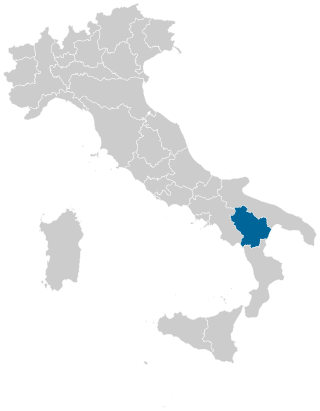
Basilicata is one of the 29 constituencies represented in the Chamber of Deputies, the lower house of the Italian parliament. The constituency currently elects 6 deputies. Its boundaries correspond to those of the Italian region of Basilicata. The electoral system uses a parallel voting system, which act as a mixed system, with 37% of seats allocated using a first-past-the-post electoral system and 61% using a proportional method, with one round of voting.

Calabria is one of the 29 constituencies represented in the Chamber of Deputies, the lower house of the Italian parliament. The constituency currently elects 21 deputies. Its boundaries correspond to those of the Italian region of Calabria. The electoral system uses a parallel voting system, which act as a mixed system, with 37% of seats allocated using a first-past-the-post electoral system and 61% using a proportional method, with one round of voting.

Campania 1 is one of the 29 constituencies represented in the Chamber of Deputies, the lower house of the Italian parliament. The constituency currently elects 29 deputies. Its boundaries correspond to those of the Metropolitan City of Naples, within the Campania region. The electoral system uses a parallel voting system, which act as a mixed system, with 37% of seats allocated using a first-past-the-post electoral system and 61% using a proportional method, with one round of voting.

Campania 2 is one of the 29 constituencies represented in the Chamber of Deputies, the lower house of the Italian parliament. The constituency currently elects 29 deputies. Its boundaries correspond to those of the provinces of Avellino, Benevento, Caserta and Salerno, within the Campania region. The electoral system uses a parallel voting system, which act as a mixed system, with 37% of seats allocated using a first-past-the-post electoral system and 61% using a proportional method, with one round of voting.
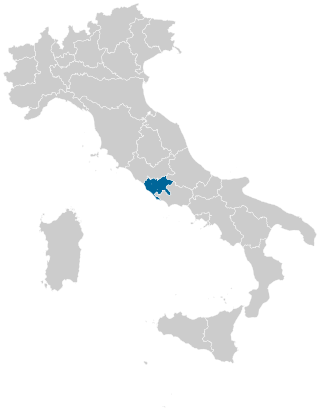
Lazio 1 is one of the 29 constituencies represented in the Chamber of Deputies, the lower house of the Italian parliament. The constituency currently elects 39 deputies. Its boundaries correspond to those of the Metropolitan City of Rome, within the Lazio region. The electoral system uses a parallel voting system, which act as a mixed system, with 37% of seats allocated using a first-past-the-post electoral system and 61% using a proportional method, with one round of voting.
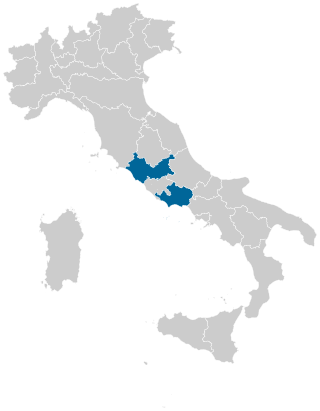
Lazio 2 is one of the 29 constituencies represented in the Chamber of Deputies, the lower house of the Italian parliament. The constituency currently elects 20 deputies. Its boundaries correspond to those of the provinces of Frosinone, Latina, Rieti and Viterbo, within the Lazio region. The electoral system uses a parallel voting system, which act as a mixed system, with 37% of seats allocated using a first-past-the-post electoral system and 61% using a proportional method, with one round of voting.

Lombardy 1 is one of the 29 constituencies represented in the Chamber of Deputies, the lower house of the Italian parliament. The constituency currently elects 40 deputies. Its boundaries correspond to those of the Metropolitan City of Milan and the Province of Monza and Brianza, within the Lombardy region. The electoral system uses a parallel voting system, which act as a mixed system, with 37% of seats allocated using a first-past-the-post electoral system and 61% using a proportional method, with one round of voting.
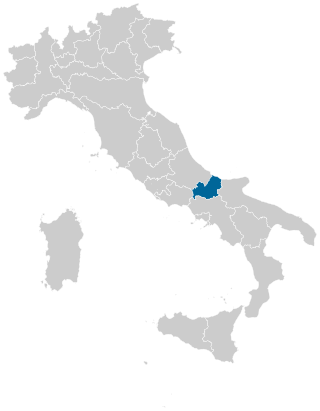
Molise is one of the 29 constituencies represented in the Chamber of Deputies, the lower house of the Italian parliament. The constituency currently elects 2 deputies, less than any other except Aosta Valley. Its boundaries correspond to those of the Italian region of Molise. The electoral system uses a parallel voting system, which act as a mixed system, with half of seats allocated using a first-past-the-post electoral system and half using a proportional method, with one round of voting.
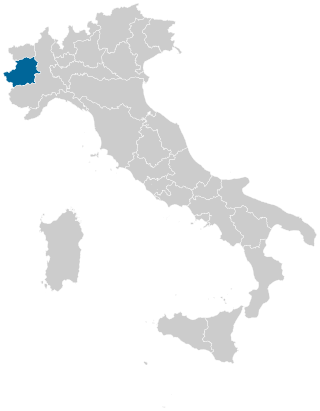
Piedmont 1 is one of the 29 constituencies represented in the Chamber of Deputies, the lower house of the Italian parliament. The constituency currently elects 25 deputies. Its boundaries correspond to those of the Metropolitan City of Turin, within the Piedmont region. The electoral system uses a parallel voting system, which act as a mixed system, with 37% of seats allocated using a first-past-the-post electoral system and 61% using a proportional method, with one round of voting.

Piedmont 2 is one of the 29 constituencies represented in the Chamber of Deputies, the lower house of the Italian parliament. The constituency currently elects 23 deputies. Its boundaries correspond to those of the provinces of Alessandria, Asti, Biella, Cuneo, Novara, Verbano-Cusio-Ossola and Vercelli, within the Piedmont region. The electoral system uses a parallel voting system, which act as a mixed system, with 37% of seats allocated using a first-past-the-post electoral system and 61% using a proportional method, with one round of voting.

Sardinia is one of the 29 constituencies represented in the Chamber of Deputies, the lower house of the Italian parliament. The constituency currently elects 17 deputies. Its boundaries correspond to those of the Italian region of Sardinia. The electoral system uses a parallel voting system, which act as a mixed system, with 37% of seats allocated using a first-past-the-post electoral system and 61% using a proportional method, with one round of voting.
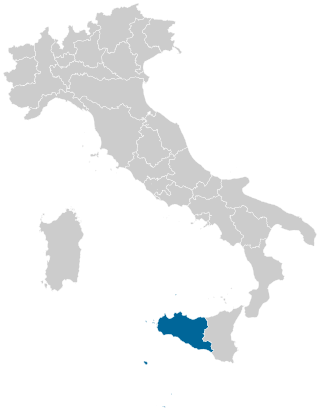
Sicily 1 is one of the 29 constituencies represented in the Chamber of Deputies, the lower house of the Italian parliament. The constituency currently elects 25 deputies. Its boundaries correspond to those of the Metropolitan City of Palermo and the provinces of Agrigento, Caltanissetta and Trapani, within the Sicily region. The electoral system uses a parallel voting system, which act as a mixed system, with 37% of seats allocated using a first-past-the-post electoral system and 61% using a proportional method, with one round of voting.
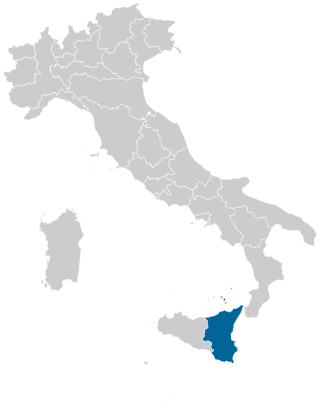
Sicily 2 is one of the 29 constituencies represented in the Chamber of Deputies, the lower house of the Italian parliament. The constituency currently elects 24 deputies. Its boundaries correspond to those of the Metropolitan City of Catania and the provinces of Enna, Messina, Ragusa and Siracusa, within the Sicily region. The electoral system uses a parallel voting system, which act as a mixed system, with 37% of seats allocated using a first-past-the-post electoral system and 61% using a proportional method, with one round of voting.

Trentino-Alto Adige/Südtirol is one of the 29 constituencies represented in the Chamber of Deputies, the lower house of the Italian parliament. The constituency currently elects 11 deputies. Its boundaries correspond to those of the Italian region of Trentino-Alto Adige/Südtirol. The electoral system uses a parallel voting system, which act as a mixed system, with 37% of seats allocated using a first-past-the-post electoral system and 61% using a proportional method, with one round of voting.
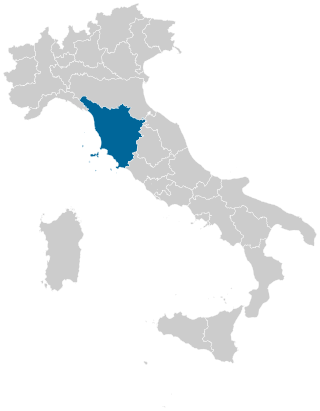
Tuscany is one of the 29 constituencies represented in the Chamber of Deputies, the lower house of the Italian parliament. The constituency currently elects 39 deputies. Its boundaries correspond to those of the Italian region of Tuscany. The electoral system uses a parallel voting system, which act as a mixed system, with 37% of seats allocated using a first-past-the-post electoral system and 61% using a proportional method, with one round of voting.

Umbria is one of the 29 constituencies represented in the Chamber of Deputies, the lower house of the Italian parliament. The constituency currently elects 9 deputies. Its boundaries correspond to those of the Italian region of Umbria. The electoral system uses a parallel voting system, which act as a mixed system, with 37% of seats allocated using a first-past-the-post electoral system and 61% using a proportional method, with one round of voting.
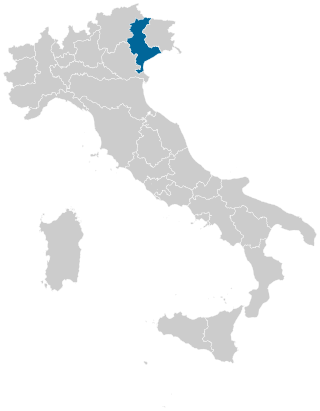
Veneto 1 is one of the 29 constituencies represented in the Chamber of Deputies, the lower house of the Italian parliament. The constituency currently elects 20 deputies. Its boundaries correspond to those of the Metropolitan City of Venice and the provinces of Belluno and Treviso, within the Veneto region. The electoral system uses a parallel voting system, which act as a mixed system, with 37% of seats allocated using a first-past-the-post electoral system and 61% using a proportional method, with one round of voting.

Veneto 2 is one of the 29 constituencies represented in the Chamber of Deputies, the lower house of the Italian parliament. The constituency currently elects 30 deputies. Its boundaries correspond to those of the provinces of Padova, Rovigo, Verona and Vicenza, within the Veneto region. The electoral system uses a parallel voting system, which act as a mixed system, with 37% of seats allocated using a first-past-the-post electoral system and 61% using a proportional method, with one round of voting.




























